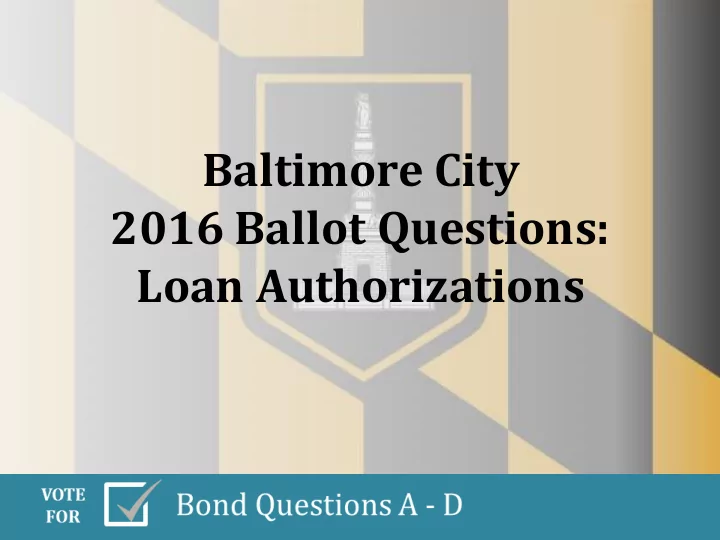

Baltimore City 2016 Ballot Questions: Loan Authorizations
Background • Per the City’s charter, voters must authorize the city to issue general obligation (G.O.) bonds to fund parts of its capital program. • The bond issue questions appear on the ballot every two years. • The questions are referred to as loan authorizations, as voters are authorizing the City to issue debt that will be paid back over time.
Background • There are four questions in 2016: – Affordable Housing Loan (new) – Schools Loan – Community and Economic Development Loan – Recreation, Parks, and Public Facilities Loan • The loans total $130 million over two years. • Amounts are based on best practices in municipal budgeting. • If approved by voters in November 2016, funds will be available in FY 2018 and FY 2019.
Background • These G.O. bonds are a key piece of the city’s capital improvement funding strategy. • G.O. Bonds help leverage millions of dollars in state, federal, and private funding. *amounts in $1,000s
Affordable Housing Loan
Affordable Housing Loan • Up to $6 million over two years • For affordable housing projects • Eligible uses would include acquisition, preservation, production of new housing, demolition, rental assistance, housing counseling and project finance comprised of loans (including forgivable or fully amortizing) or grants as well as other related activities • 2016 is the first time this question will appear on the ballot
Gibbons Commons Gibbons Commons is an affordable housing development for low-income families and disabled adults in Southwest Baltimore. The project used $850,000 in gap financing from the City, leveraging over $18 million in low-income housing tax credits and private development funding.
Schools Loan
Schools Loan • Up to $34 million over two years • To be used to improve City schools facilities • Complements the 21 st Century Schools program • Will be primarily used to fund routine capital maintenance projects such as windows, doors, and HVAC systems, along with 3 new schools
Graceland Park – O’Donnell Heights Elementary/Middle School The new Graceland Park – O’Donnell Heights Elementary/Middle School will use $6.5 million in G.O. Bonds and over $37 million in state public school construction program funding. The completely new building will also use a Maryland Energy Administration grant to install geothermal and solar energy systems, to become the first Net Zero Energy school in Baltimore City.
Community and Economic Development Loan
Community and Economic Development Loan • Up to $45 million over two years • For community and economic development activities • Eligible activities include planning, development, and execution of community development programs • Includes grants and loans to organizations working with the City
Johnston Square Redevelopment The Department of Housing and Community Development (DHCD) is using $1.5 million from the 2014 Community and Economic Development Loan, combined with federal and private funds, to take a comprehensive approach to revitalizing the Johnston Square neighborhood. DHCD works with community groups, demolishing unsafe and vacant structures, and allowing other entities to put the land to use by building new affordable housing, installing community green spaces, and more.
Recreation, Parks and Public Facilities Loan
Recreation and Parks and Public Facilities Loan • Up to $45 million over two years • For improvements to public buildings and land • Potential uses include libraries, parks, municipal buildings, and other city-owned properties
C.C. Jackson Recreation Center The Department of Recreation and Parks used $2.2 million from the Parks and Public Facilities Loan, leveraging $5.3 million of other funds, to completely renovate the C.C. Jackson Recreation Center in Park Heights. The new center includes fitness rooms, community space, computer rooms, and an indoor gym, along with a new playground, parking facility, and basketball court outdoors.. In addition, an athletic complex with new football and baseball fields, bleachers, and lighting was developed in partnership with the Ripken Baseball Foundation.
Recommend
More recommend